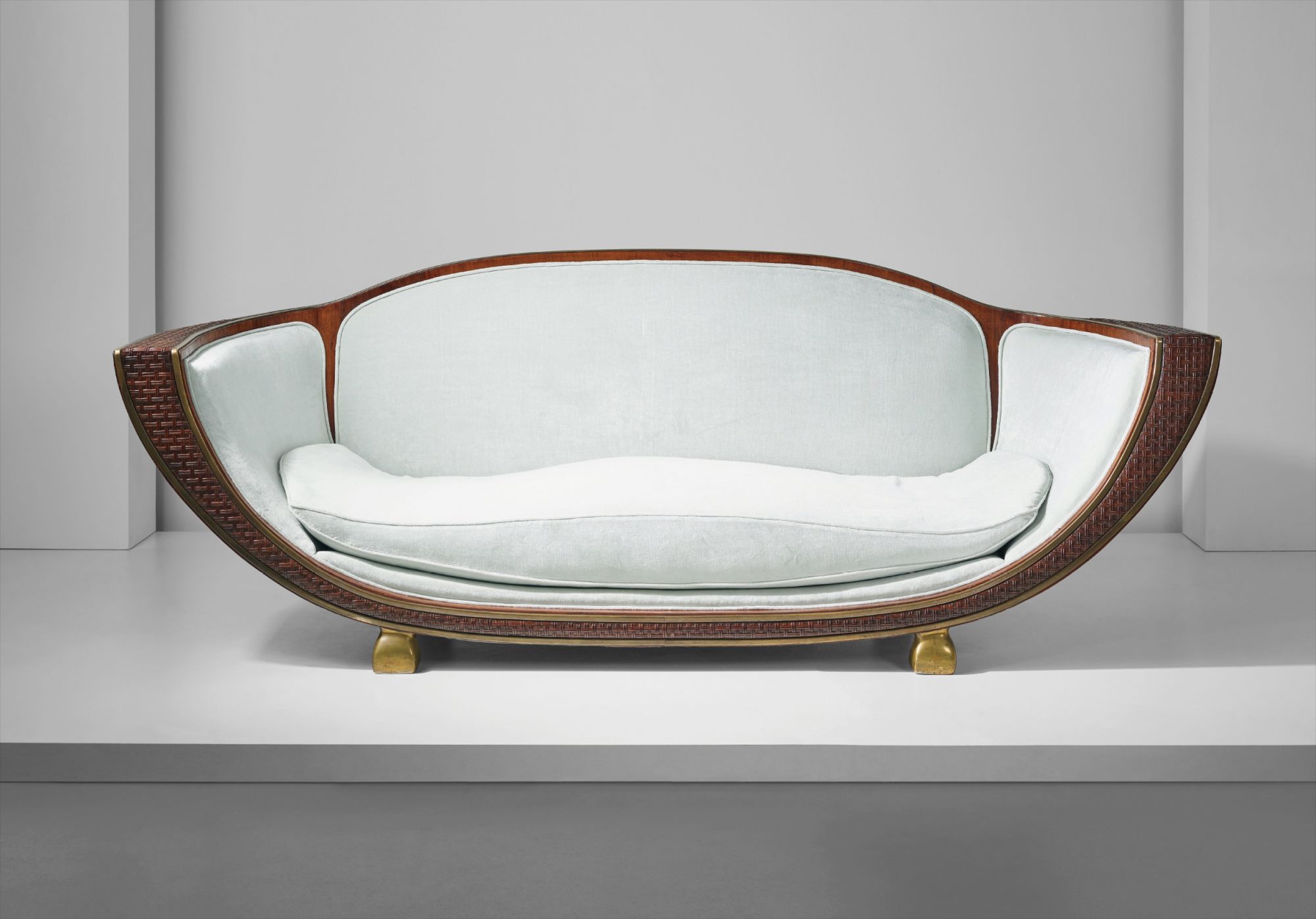

15
Marcel Coard
Important Canapé Gondole
Full-Cataloguing
MARCEL COARD’S ‘CANAPÉ GONDOLE’
Amélie Marcilhac, March 2016
Jacques Doucet, the great couturier and patron of the arts, was among the most iconic figures of the Art Deco period. From 1928, his studio on rue Saint-James in Neuilly was a theatre of artistic revolution, as avant-garde in furniture as it was in pictures. His objective was to provide a showcase that would inspire creativity and expression among his protégés. Pablo Picasso’s “Les Demoiselles d’Avignon”, the most telling example, hung above Joseph Csaky’s stairwell and jealously watched over this hotbed of creativity.
Marcel Coard was among the elite decorators and artists chosen by this patron; discovered by Doucet in 1914, Coard created for him that year a bombé vitrine in Macassar ebony, ivory, and mother-of-pearl which now resides in the Musée des Arts Décoratifs, Paris.
Though Marcel Coard had his own style, the influence of his patron is evident in the works he created for him. As was his way with the great majority of artists working for him, Doucet influenced his commissions with his own style and tastes, going beyond mere sponsor to play the role of guide and master of the arts. Whereas gilding and curves predominated in his studio on the avenue du Bois (his earlier residence), at his studio on rue Saint-James he gave pride of place to primitive art, and their geometric and rustic aesthetic provided new sources of inspiration to the decorators and artisans, allowing them to imagine new revolutionary forms all the while favouring the use of precious materials.
In this way, Coard created for the couturier a work that was the perfect synthesis of these two influences. Around 1924, he created the famous canapé gondole that was displayed on the avenue du Bois. It was reproduced in 1925 for an article in Fémina, before being installed in the provocative rue Saint-James salon in 1928. This Indian rosewood canapé, inlaid with two rows of ivory and entirely covered in strips of wood carved to resemble basketry, is a supreme achievement on the part of the ébéniste. The two front feet are rounded in accordance with the ovoid aesthetic and are accentuated by the two quadrangular rear feet and are only polished on the front so as not to weigh down the aesthetic. This canapé achieved the second-highest price at the auction of Doucet’s estate, which took place in Paris on November 8th, 1972, surpassed only by an Eileen Gray screen. Today in the Virginia Museum of Fine Arts, Richmond (VMFA), this canapé is the quintessential Art Deco object, a celebration of Marcel Coard at the height of his powers.
Coard also created four brass vitrines for Doucet, two of which were published in L’Illustration in May 1930. While the pieces imagined and created for Jacques Doucet are unique, as much in their forms as in their materials, similar vitrines were also made around 1925 for Paul Cocteau, the great Parisian stockbroker and friend of Doucet. However, Coard modified the materials by only using parchment on the top part and not on the entire piece like on those he designed for the couturier.
The present gondola canapé is the only other example in which Marcel Coard duplicated a model previously created for Doucet. It has the same carved basketwork-motif over the entire structure and a similar base and seat and shows only one significant change: on the present model the ivory has been replaced in favour of silvered bronze (today oxidised to a deep colour) in order to underline the structure of the canapé and to highlight the front feet. Though less African, this choice allowed the designer to emphasise the strong contrast between the dark brown of the rosewood and the whiteness of the silvered bronze, contrasts which he would hold dear throughout his career, playing with inlays of lapis lazuli, mother-of-pearl, malachite, and again ivory.
Only someone in Doucet’s own circle, close to Coard, could have commissioned this work and would have been able to honour the designer with such an order. Doucet’s Paris milieu was very select and exclusive, and he surrounded himself with eminent figures such as André Breton and André Suarès, who consulted him on art purchases from all genres. The proportions of the canapé as well as its cushions, back, and base are extremely similar to the canapé in the VMFA. With the exception of the use of silvered bronze instead of ivory, the present model is a mirror image of the sofa created for Jacques Doucet.
The origin of the commission is not known today, despite extensive research in The Hague. However, the decorator’s stamp, which appears in two places on the canapé, as on another piece created for Jacques Doucet, allows us to date this piece to around 1925-1928. The present canapé and the one commissioned by Jacques Doucet are the only known versions of this model.
Amélie Marcilhac,
March 2016
Marcel Coard
French | B. 1889 D. 1974Like many other furniture designers of the Art Deco period, Marcel Coard began his career catering to the traditional tastes of his customers, only making unique and creative pieces for certain clients. His furniture design transcended the historicism and modernism that dominated the Art Deco style, and ultimately reflects the concepts and aesthetics of the early twentieth-century avant-garde as much as it does a particular decorating style.
Coard is most famous for the furniture he designed for the great couturier and patron of the arts Jacques Doucet. Widely published, Doucet's interior has come to define modern collecting practices and in particular was a formative inspiration for Yves Saint Laurent and Pierre Bergé. Coard’s work was re-discovered in the historic 1972 auction of Doucet's collection, which achieved previously unrealized results in the still nascent Art Deco market.